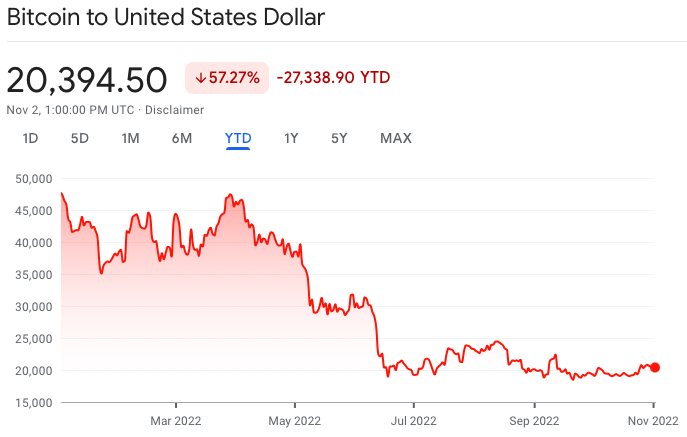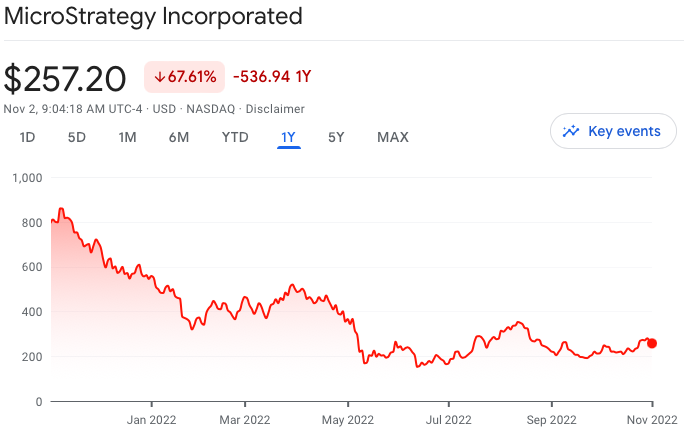MicroStrategy (Nasdaq: MSTR) announced on Tuesday its Q3 2022 financial results toplined by a quarterly revenue of US$125.4 million, up from Q2 2022’s US$122.1 million but down from Q3 2021’s US$128.0 million.
“For the third quarter, MicroStrategy achieved strong 51% growth year-over-year in subscription services revenues, record growth year-over-year in current subscription billings, and total revenue growth year-over-year on a constant currency basis,” said newly-installed CEO Phong Le, who replaced Chairman Michael Saylor.
Cost of revenues increased year-on-year, leading the firm to notch a 79.8% gross margin–marginally unchanged from the 79.4% last quarter but down from last year’s 82.6%.
On top of this, the company’s crypto investment strategy notched it another US$727,000 “minimal” loss due to digital asset impairment. This follows after the firm recorded US$917.8 million in impairment losses last quarter.
At quarter’s end, the carrying value of MicroStrategy’s digital assets (comprised of roughly 130,000 bitcoins) is US$1.993 billion, reflecting cumulative impairment losses of US$1.990 billion since purchase and an average carrying amount per bitcoin of about US$15,331.
Included in this balance is the recently bought bitcoins, “furthering the commitment” to the firm’s bitcoin strategy.
“We continue the commitment to our strategy in Q3 and purchased 301 additional Bitcoins for approximately US$6 million at an average purchase price of US$19,000 – US$19,860 per Bitcoin, net of fees and expenses,” Le said in the earnings call. The purchased bitcoins were acquired with excess cash, according to the company.
Le reiterated that the strategy is “to acquire and hold Bitcoin for the long-term” and they do not currently plan “to engage in sales of Bitcoin.”
The company seems to be banking on the Financial Accounting Standards Board’s recent decision on measuring cryptocurrency assets on financial sheets using fair value accounting. This could mean that gains and losses on the value of these digital assets can be recognized in comprehensive income each reporting period.
“If finally adopted and implemented, we believe fair value accounting will improve upon the current, unfavorable intangible accounting treatment applicable to bitcoin holdings and will promote additional institutional adoption of bitcoin as an asset class,” CFO Andrew Kang added.
However, bitcoin hasn’t yet been able to recover from what is referred to as “crypto winter”–with the digital asset still skirting the US$20,000-mark since it has fallen 57% year-to-date.

The recent moderate bitcoin purchase seems to be aligned with the firm’s seemingly hesitation on buying the price dip as the company has sustained big losses on impairment.
Bitcoin maximalists and bulls–like Saylor–continue to support and rally confidence on the crypto asset, banking on its supposed rise again last observed in Q4 2021.
In fact, the controversial crypto bull executive seems to have doubled down on crypto investment, after he announced the company would be splitting his two top executive positions in two–with him taking on the chairmanship to focus on turning the company into a bitcoin investment vehicle.
#Bitcoin is Ethical.
— Michael Saylor⚡️ (@saylor) November 2, 2022
The quarter ended still with a net loss of US$27.1 million, an improvement from last quarter’s US$1.06 billion loss and last year’s US$36.1 million loss. The bottomline translates to US$2.39 loss per share.
Calibrating for financial items–including a share-based compensation expense of US$16.9 million–non-GAAP net loss came down to US$10.8 million, up from last year’s US$28.4 million.
The firm also ended the quarter with a cash balance of US$60.4 million from last quarter’s US$69.4 million. This puts the balance of the current assets at US$202.3 million while current liabilities ended at US$260.5 million.
Saylor: Bitcoin is winning
Back in August, Saylor has defended the firm’s bitcoin strategy–which just notched a big impairment loss then–saying the firm’s value shot up since it adopted said strategy.
Since @MicroStrategy adopted a #Bitcoin Strategy, its enterprise value is up +730% (+$5 billion) and $MSTR is up +123%. Performance of BTC is +94%, S&P 500 +23%, Nasdaq +13%, Gold -13%, Bonds -14%, Silver -29%. GOOG +54%, AAPL +43%, MSFT +34%, AMZN -14%, META -39%, NFLX -53%. pic.twitter.com/BWHPhbOg0d
— Michael Saylor⚡️ (@saylor) August 3, 2022
“We generally pick August 10, 2020, as that date to go back to because that was the date before we purchased $250 million worth of Bitcoin, and we announced a $250 million Dutch auction or share buyback,” Saylor said in the earnings call.
While the firm’s shares are still up roughly 74% from that August 2020 period, they have gradually fell in value over the years, losing 54% year-to-date and 68% in the last 12 months.

In the earnings call, Saylor also defended the bitcoin investment anew by comparing it to gold.
“Gold, and many of you have followed us in our journey will recall that — when we started on this path, our number one question was, should we buy Bitcoin or should we buy gold. Gold is down 19%. In that same time period, the Bitcoin is up 116%. That makes sense to us. Gold is the hard money solution for the 19th century, and Bitcoin is the hard monetary asset for the 21st century,” Saylor explained.
He added that compared to bitcoin, the bond index and silver have also lost their value by 22% and 33%, respectively, making them not ideal for investment.
“So, I think, when you look at the story here, Bitcoin is winning, but MicroStrategy is winning even more than the Bitcoin right now because of our levered long Bitcoin strategy we pursued,” Saylor claimed.
The chairman, when asked about diversifying the bitcoin investment, said “the best strategy for us is long bitcoin” and “only bitcoin as a digital asset and to the degree that we’re going to look for returns in excess of the bitcoin return.” He believes that other strategies–like bitcoin derivatives–“are dilutive to the Bitcoin strategy.”
“I’ve recorded analysis on Bitcoin versus real estate property. We’ve analyzed Bitcoin versus gold. We’ve analyzed Bitcoin versus every other crypto asset. We’ve analyzed bitcoin versus bonds. We’ve looked at bitcoin versus equity, and we’ve looked at Bitcoin. We’ve considered all of those, and our concludes Bitcoin is the apex property and there’s nothing better,” he added.
Kang also explained that the current bitcoin acquisition strategy, while considering the entirety of the balance sheet, has been demonstrated that when the firm has excess cash from operations in any given quarter, “those excess proceeds can be used to buy Bitcoin.”
“As well as proceeds from larger capital markets activities, I think you can continue to expect the same pretty simple strategy going forward. In terms of potential more severe macro downturn, I think we do not have any plans to adjust our Bitcoin strategy,” Kang added in the earnings call.
MicroStrategy last traded at $260.50 on the Nasdaq.
Information for this briefing was found via Edgar and the companies mentioned. The author has no securities or affiliations related to this organization. Not a recommendation to buy or sell. Always do additional research and consult a professional before purchasing a security. The author holds no licenses.









